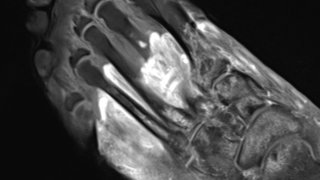
Medical imaging has revealed that COVID-19 can in some cases "cause the body to attack itself," marking the first glimpse at what is behind mysterious severe, long-lasting and sometimes bizarre symptoms - even in those who never knew they contracted the virus, a new study has found.
From rheumatoid arthritis flares to autoimmune issues to “COVID toes,” there have been several reports of unusual and potentially concerning symptoms associated with coronavirus, many of which have been a mystery during the pandemic.
WATCH ANYTIME FOR FREE
>Stream NBC10 Boston news for free, 24/7, wherever you are. |
But according to a Northwestern Medicine study, radiological imaging has "for the first time, confirmed and illustrated the causes of these symptoms."
“We’ve realized that the COVID virus can trigger the body to attack itself in different ways, which may lead to rheumatological issues that require lifelong management,” corresponding author Dr. Swati Deshmukh said in a release.
Get updates on what's happening in Boston to your inbox. Sign up for our >News Headlines newsletter.
The study, which was published Wednesday in the journal Skeletal Radiology, showed that imaging through CT scans, MRIs and ultrasounds can help explain why some patients suffer from "prolonged musculoskeletal symptoms" after contracting the virus.
“Many patients with COVID-related musculoskeletal disorders recover, but for some individuals, their symptoms become serious, are deeply concerning to the patient or impact their quality of life, which leads them to seek medical attention and imaging,” Deshmukh, an assistant professor of musculoskeletal radiology at Northwestern University Feinberg School of Medicine and a Northwestern Medicine musculoskeletal radiologist, said. “That imaging allows us to see if COVID-related muscle and joint pain, for example, are not just body aches similar to what we see from the flu — but something more insidious.”
In some cases, the imaging can even suggest a patient has had COVID-19, but otherwise did not know they had it, the study revealed.
U.S. & World
According to the Deshmukh, experts look for fluid or swelling in tissues, collections of blood, or gangrene.
“In some patients, the nerves are injured and in others, the problem is impaired blood flow,” Deshmukh said.
Bizarre symptoms like "COVID toes," which in some cases can last for months, have been reported throughout the pandemic, though are not as prevalent as other common symptoms associated with the virus.
According to the study, however, there have been a "surprising number of extra-pulmonary manifestations" associated with the virus, along with emerging reports of other abnormalities and musculoskeletal disorders, which "can have dire short- and long-term consequences."
Such long-term inflammation recently made headlines after Gwyneth Paltrow revealed she has been suffering from certain ailments for months after her initial diagnosis.
"I had COVID-19 early on, and it left me with some long-tail fatigue and brain fog," Paltrow wrote in a recent post for her website, Goop.
Paltrow said she had tests done in January that showed she had "really high levels of inflammation in my body."
Researchers in the Northwestern study said they hope their findings will help doctors to properly treat certain rare ailments the can come with a coronavirus diagnosis.
“I think it’s important to differentiate between what the virus causes directly and what it triggers the body to do,” Deshmukh said. “It’s important for doctors to know what’s happening in order to treat correctly.”



